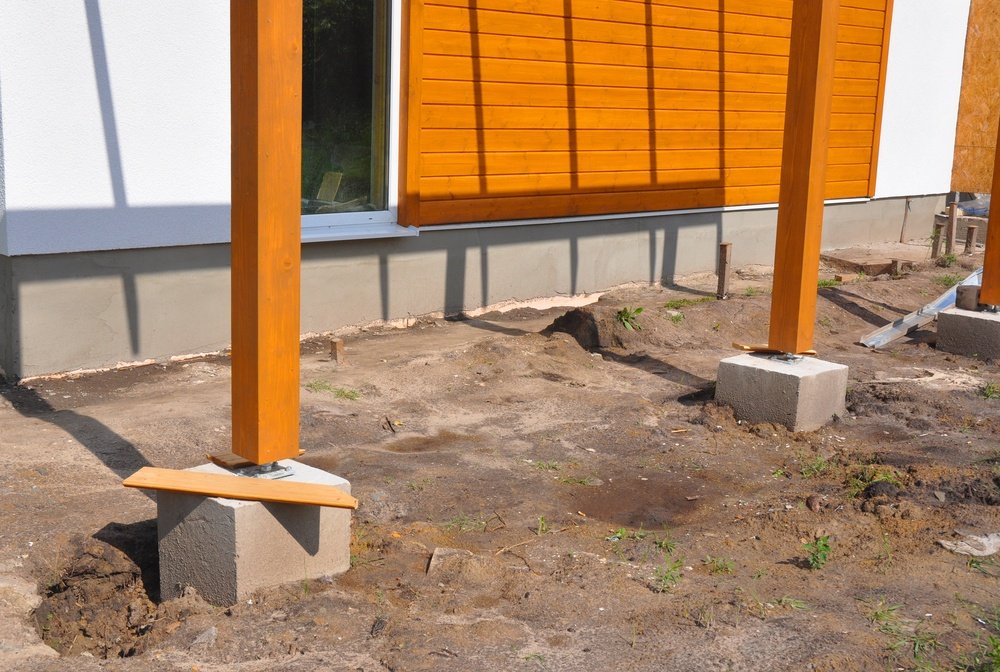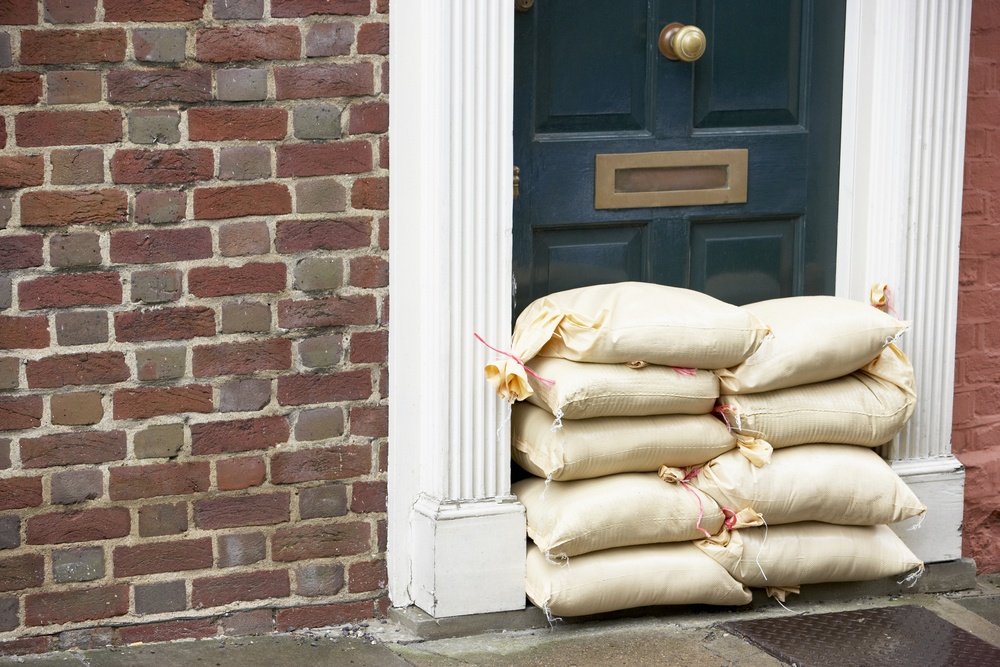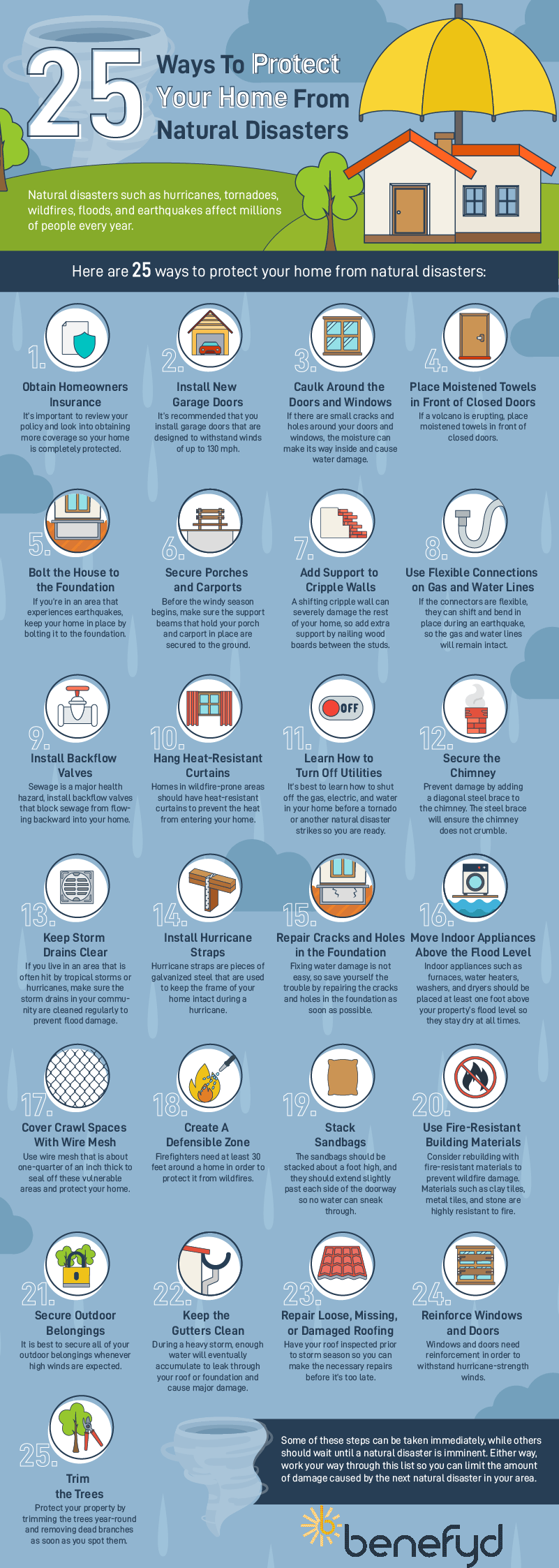25 Ways To Protect Your Home From Natural Disasters
Natural disasters such as hurricanes, tornadoes, wildfires, floods, and earthquakes affect millions of people every year, and there’s no sign that this will change anytime soon. In fact, the U.S. experienced a historic number of natural disasters last year, including three major hurricanes in less than a month.
These natural disasters put countless people in serious danger, and they also cause a significant amount of damage. In 2017, the historic disasters caused approximately $306.2 billion in damage. Sadly, residential home damage accounts for a large percentage of the total damages. Since these natural disasters can strike virtually anywhere in the U.S., all homeowners should prepare for the worst. Here are 25 ways to protect your home from natural disasters:
1. Obtain Homeowners’ Insurance
First, make sure you have homeowners’ insurance that will cover a significant amount of repairs in the event of a natural disaster. Basic policies may not cover certain damage caused by natural disasters, such as floods. It’s important to review your policy and look into obtaining more coverage so your home is completely protected.
2. Install New Garage Doors
If your garage door is not built to withstand high winds, it can easily blow off during a hurricane. The high winds will then make their way into your home, causing so much pressure to build up within the structure that the roof eventually flies off. To prevent this catastrophic damage, it’s recommended that you install garage doors that are designed to withstand winds of up to 130 mph.
3. Caulk Around the Doors and Windows
The high winds of a storm can blow the rain hard enough to push it against your home. If there are small cracks and holes around your doors and windows, the moisture can make its way inside and cause water damage. Prevent this problem by applying a fresh layer of caulk around the points of entry in your home before the rainy season begins.
4. Place Moistened Towels in Front of Closed Doors
There are nearly 170 active volcanoes in the U.S., so people who live near these volcanoes need to learn how to protect their property. If a volcano is erupting, place moistened towels in front of closed doors. High winds can blow lava and ash into your home through these small spaces, but the towels will keep your home safe.
5. Bolt the House to the Foundation
Some earthquakes are so strong that they can separate a home from its foundation, causing thousands of dollars in damage. If you’re in an area that experiences earthquakes, keep your home in place by bolting it to the foundation. Hire a professional to bolt the sill plate of your home to the foundation with anchor bolts, which are strong enough to withstand an earthquake’s tremors.

6. Secure Porches and Carports
If your porch and carport are not secured, high winds can rip them off of your home, leaving huge holes that could lead to further wind damage. Before the windy season begins, make sure the support beams that hold your porch and carport in place are secured to the ground.
7. Add Support to Cripple Walls
A cripple wall is the short wall that creates the crawl space beneath the first floor of your home. These walls are not strong enough to withstand earthquakes, so they often start to shift when the tremors begin. A shifting cripple wall can severely damage the rest of your home, so add extra support by nailing wood boards between the studs.
8. Use Flexible Connections on Gas and Water Lines
An earthquake’s tremors can rip the gas and water lines away from their connection points, which can cause serious injuries and property damage. Fortunately, this problem can be easily prevented with flexible connectors. If the connectors are flexible, they can shift and bend in place during an earthquake, so the gas and water lines will remain intact.
9. Install Backflow Valves
Floodwaters can push the sewage in sewer lines back up through the drain pipes and into your home. Sewage is a major health hazard, and it can also cause a great deal of damage to your property. Don’t wait for this to happen to you—install backflow valves that block sewage from flowing backward into your home.

10. Hang Heat-Resistant Curtains
The heat from a nearby wildfire can creep into your home through the windows. If it’s hot enough, this heat can actually start a fire within your home. For this reason, homes in wildfire-prone areas should have heat-resistant curtains to prevent the heat from entering your home.
11. Learn How to Turn Off Utilities
It’s imperative to turn off your utilities during a tornado to prevent fires, flooding, and gas leaks, but many people aren’t sure how to do it. It’s best to learn how to shut off the gas, electric, and water in your home before a tornado or another natural disaster strikes so you are ready to act quickly if necessary.
12. Secure the Chimney
Earthquakes are powerful enough to knock chimneys over—even if the rest of your home remains intact. Prevent damage by adding a diagonal steel brace to the chimney. The steel brace will ensure the chimney does not crumble when the world starts to shake.
13. Keep Storm Drains Clear
Excess rain and groundwater is supposed to drain through the storm drains, which are located throughout residential communities. However, the water will not have anywhere to go if the storm drains are clogged with debris. If you live in an area that is often hit by tropical storms or hurricanes, make sure the storm drains in your community are cleaned regularly to prevent flood damage.
14. Install Hurricane Straps
Hurricane straps are pieces of galvanized steel that are used to keep the frame of your home intact during a hurricane. The straps can be installed to connect your roof to the wall, second story to the first story of your home, or the walls to the foundation to ensure your home can withstand winds of more than 100 mph.
15. Repair Cracks and Holes in the Foundation
Floodwater can sneak into your home through tiny cracks and holes in your foundation. Once inside, the water can damage the flooring, drywall, and personal belongings. Fixing water damage is not easy, so save yourself the trouble by repairing the cracks and holes in the foundation as soon as possible.
16. Move Indoor Appliances Above the Flood Level
Indoor appliances such as furnaces, water heaters, washers, and dryers should be placed at least one foot above your property’s flood level so they stay dry at all times. A furnace, for example, that is left in floodwaters could catch fire or explode, which can lead to catastrophic damage. Don’t take this chance—move your appliances above the flood level.
17. Cover Crawl Spaces With Wire Mesh
Wind can blow embers from nearby wildfires into your home, so it’s important to seal off any entry points, including crawl spaces. Use wire mesh that is about one-quarter of an inch thick to seal off these vulnerable areas and protect your home.
18. Create A Defensible Zone
Firefighters need at least 30 feet around a home in order to protect it from wildfires. Make sure they have the space they need by creating a defensible zone that fits this description. This area should be free from trees, grass, and dead leaves, which can fuel a wildfire.

19. Stack Sandbags
If you are in a flood-prone area, stack sandbags around your doors if a hurricane is expected to hit in the near future. The sandbags should be stacked about a foot high, and they should extend slightly past each side of the doorway so no water can sneak through.
20. Use Fire-Resistant Building Materials
Consider rebuilding portions of your home with fire-resistant materials to prevent wildfire damage. Roofing materials such as clay tiles, metal tiles, and stone are highly resistant to fire. You can also replace your existing window frames with steel frames. These upgrades can keep your house safe when it is surrounded by wildfire.
21. Secure Outdoor Belongings
Hurricane or tornado-strength winds can turn kids’ toys, patio furniture, and other outdoor belongings into projectiles. These items can crash through your windows or damage the exterior of your home. Because of this, it is best to secure all of your outdoor belongings whenever high winds are expected.
22. Keep the Gutters Clean
If your gutters are clogged, hurricane rainwater will start to accumulate on your roof or around the foundation. During a heavy storm, enough water will eventually accumulate to leak through your roof or foundation and cause major damage. The simple solution to this problem is keeping the gutters clean—especially during hurricane season.
23. Repair Loose, Missing, or Damaged Roofing
Hurricane and tornado-strength winds can rip loose, missing, or damaged shingles from your roof, which can lead to leaks throughout the ceiling. Have your roof inspected prior to storm season so you can make the necessary repairs before it’s too late.
24. Reinforce Windows and Doors
Windows and doors need reinforcement in order to withstand hurricane-strength winds. A temporary solution is to board up the windows and doors with plywood whenever a hurricane is headed your way. However, you can also permanently fix this problem by installing reinforced doors and windows that are designed to withstand hurricane-strength winds.
25. Trim the Trees
High winds can snap large branches off of untrimmed trees and turn them into dangerous projectiles. In dry climates, untrimmed trees can serve as fuel to the fire, helping it spread throughout your property until it makes its way to your home. Protect your property by trimming the trees year-round and removing dead branches as soon as you spot them.
Some of these steps can be taken immediately, while others should wait until a natural disaster is imminent. Either way, work your way through this list so you can limit the amount of damage caused by the next natural disaster in your area.



